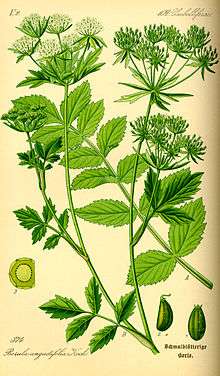Berula
| Berula | |
|---|---|
 | |
| Berula erecta | |
| Scientific classification | |
| Kingdom: | Plantae |
| (unranked): | Angiosperms |
| (unranked): | Eudicots |
| (unranked): | Asterids |
| Order: | Apiales |
| Family: | Apiaceae |
| Genus: | Berula W.D.J.Koch |
Berula is a cosmopolitan genus of flowering plant in the carrot family, whose species are known as water parsnip,[1] as are some other plants in Apiaceae such as Sium latifolium and Sium suave. It is easily confused with the highly toxic water hemlock. Water parsnip is a widespread aquatic plant found across Eurasia, Africa, North America, and elsewhere. It is a perennial plant forming stolons at the base where it roots in mud, often underwater. It extends hollow stems and umbels of white flowers. The leaves are fernlike and have several narrow to rounded leaflets.
Taxonomy
As of February 2015, The Plant List accepts five species:
- Berula bracteata (Roxb.) Spalik & S.R.Downie
- Berula burchellii (Hook.f.) Spalik & S.R.Downie
- Berula erecta (Huds.) Coville
- Berula imbricata (Schinz) Spalik & S.R.Downie
- Berula repanda (Welw. ex Hiern) Spalik & S.R.Downie
Uses
The Zuni people use Berula erecta as an ingredient of "schumaakwe cakes" and used it externally for rheumatism.[2] An infusion of whole plant used as wash for rashes and athlete's foot infection.[3]
Conservation
Berula erecta (lesser water parsnip) is a component of Purple moor grass and rush pastures - a type of Biodiversity Action Plan habitat in the UK. It occurs on poorly drained neutral and acidic soils of the lowlands and upland fringe. It is found in the South West of England, especially in Devon.
References
- ↑ Calflora taxon report, University of California: Berula erecta
- ↑ Stevenson, Matilda Coxe 1915 Ethnobotany of the Zuni Indians. SI-BAE Annual Report #30 (p.44)
- ↑ Camazine, Scott and Robert A. Bye 1980 A Study Of The Medical Ethnobotany Of The Zuni Indians of New Mexico. Journal of Ethnopharmacology 2:365-388(p.379)